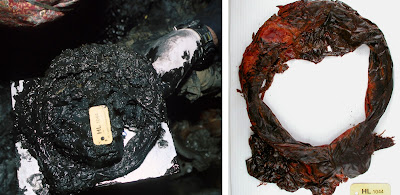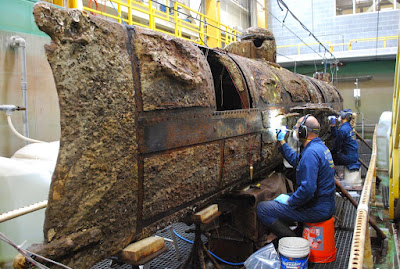 |
| James A. Wicks' conserved bandana (Photos courtesy of Friends of the Hunley) |
 |
| The item shortly after recovery and during the conservation process |
A Friends of the Hunley social media post Wednesday about the conservation of a knotted
bandana worn around the neck of crew member James A. Wicks garnered more than
950 shares within 24 hours.
 |
| James A. Wicks |
The exacting
work on the artifact was detailed in the winter 2007 issue of The Blue
Light, the newsletter of the Friends group.
“We will at times showcase past work on the project,” Kellen Butler,
president and executive director of the nonprofit museum, told the Picket via email.
Since its recovery from the Charleston (S.C.) Harbor in 2000, the
Confederate submarine has been undergoing extensive conservation at the Warren Lasch Conservation Center in North Charleston. From time to time, the
Friends of the Hunley posts photographs of an item before and after
conservation. Such was the case with Wicks' silk bandana.
“When what
appeared to be nothing more than a blob of mud was found in the Hunley crew
compartment during excavation, it was hard to detect is was a fascinating – and
beautiful – piece of history,” reads a Facebook post.
Wicks and seven others lost their
lives in the Hunley during a mission that made history.
On the moonlit evening of Feb. 17, 1864, the
40-foot iron vessel -- bullets pinging off its iron exterior -- planted a
torpedo in the hull of the Union ship USS Housatonic, setting off a charge that sent the Federal
vessel and five crew members to the sandy bottom outside Charleston Harbor
within minutes. The Hunley became
the first submarine to sink an enemy warship.
 |
| Conservators several years ago at lab in North Charleston (Friends of the Hunley) |
The Hunley, too, was lost, but exactly why
remains a mystery. A host of theories -- from pressure emitted by the explosion, suffocation, a "lucky shot," drowning or other factors -- has
been debated for decades. The position of the crew found during conservation showed
no signs of panic.
Wicks and the conservation of his fragile garment each have an interesting story.
Mary W. Ballard, a senior textile conservator at
the Smithsonian Institution, consulted by phone and traveled to the museum and
assisted in the challenging work of bringing the bandana back to life.
“Saving this
unique artifact created a challenging question for conservators: how do you dry
a fabric that has been waterlogged for over a century? Complicating matters,
the bandana was also completely covered with mud and a metallic-like concretion,”
reads The Blue Light article.
Conservators first
tested dozens of detached small samples with various chemical treatments before
deciding how to treat the bandana itself.
 |
| Details of the bandana during and after conservation (Friends of the Hunley) |
To remove
water, they applied a technique called vacuum freeze-drying. The process dries the
fabric without applying tension to its fragile fibers.
“We will
never know the true color of the bandana since the fabric’s vegetable dye was
lost long ago,” the article states. “Still, the completed artifact speaks to
the delicate skill of conservation and offers a rare insight into the divided
loyalties many may have felt during the Civil War.”
What
divided loyalties?
Wicks
-- a Southerner by birth -- was in the U.S. Navy at the outbreak of the Civil
War. When the USS Congress was crippled by the Confederate warship CSS Virginia
at the Battle of Hampton Roads in March 1862, he switched sides, according to
the Friends of the Hunley.
He was about 45 years old when he died in the Hunley mission.
He was about 45 years old when he died in the Hunley mission.
“Given his personal history, it is not surprising Wicks is
the only crew member known to be wearing a bandana around his neck, a common
practice for enlisted Union sailors during that time,” The Blue Light surmises.
 |
| Exhibit at the Hunley museum in North Charleston (Civil War Picket photo) |
Wicks served
on the CSS Indian Chief before Hunley skipper Lt. George Dixon chose him to be
part of the eight-member crew.
The Friends
of the Hunley says the father of four girls stood nearly 5 feet 10 inches tall
and was a heavy tobacco user. He had blue eyes and brown hair, according to
records.
Wicks had the
Hunley’s sixth crank position and in an emergency, his job was to release the
aft keel block, should weight needed to be jettisoned so that the submarine could
rise from the ocean floor.
His remains
were found associated with seven US Navy buttons, which is consistent with his
military service, according to the Friends of the Hunley.
GREAT stuff, Mr Gast. Thank you, from a fellow terrorizer of children also drafted into service on various battlefield tours.
ReplyDelete